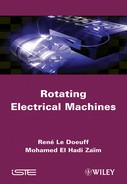Book Description
In this book a general matrix-based approach to modeling electrical machines is promulgated. The model uses instantaneous quantities for key variables and enables the user to easily take into account associations between rotating machines and static converters (such as in variable speed drives). General equations of electromechanical energy conversion are established early in the treatment of the topic and then applied to synchronous, induction and DC machines. The primary characteristics of these machines are established for steady state behavior as well as for variable speed scenarios.
Important new applications for this technology (such as wind turbines, electric propulsion systems for large ships, etc.) are addressed and the book is illustrated with a large number of informative and detailed photographs, provided by various companies at the leading edge of research and applications in the field.
Table of Contents
- Cover
- Title Page
- Copyright
- Preface
- Chapter 1: Main Requirements
- Chapter 2: Introduction to Rotating Electrical Machines
- 2.1. Introduction
- 2.2. Main notations
- 2.3. Principle of the electromechanical energy conversion
- 2.4. Continuous energy conversion
- 2.5. Non-salient and salient poles
- 2.6. Notion of pole pitch
- 2.7. Stator/rotor coupling: the “basic machine”
- 2.8. Losses within the machines
- 2.9. Nominal values
- 2.10. General sign covenant
- 2.11. Establishment of matricial equations
- 2.12. Mechanical equation
- 2.13. Conclusion
- Chapter 3: Synchronous Machines
- 3.1. Introduction
- 3.2. Introduction and equations of the cylindrical synchronous machine
- 3.3. Analysis of the synchronous machine connected to an infinite power network
- 3.4. Considerations about the salient pole synchronous machine
- 3.5. Consideration about permanent magnet machines
- 3.6. Inverted AC generators
- 3.7. Implementation of synchronous machines
- 3.8. Experimental determination of the parameters
- Chapter 4: Induction Machines
- 4.1. Introduction
- 4.2. General considerations
- 4.3. Equations
- 4.4. Equivalent circuits
- 4.5. Induction machine torque
- 4.6. Study of the stability
- 4.7. Circle diagram (or “Blondel” diagram)
- 4.8. Induction machine characteristics
- 4.9. Implementation of induction machines
- 4.10. Principle of the experimental determination of the parameters
- Chapter 5: Direct Current Machines
- 5.1. Introduction
- 5.2. Main notations
- 5.3. DC machine structure
- 5.4. DC machine equations
- 5.5. Separately excited motor
- 5.6. Series excited motor
- 5.7. Special case of the series motor: the universal motor
- 5.8. Commutation phenomena
- 5.9. Saturation and armature reaction
- 5.10. Implementation of DC motors
- Bibliography
- Index
